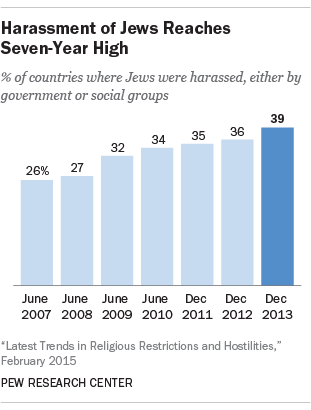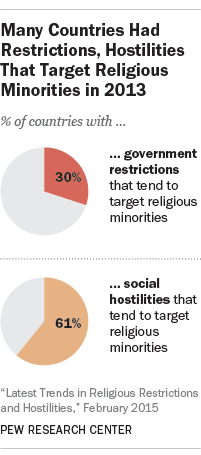Pew Research Center has been tracking data on religious restrictions in nearly 200 countries and territories since 2007, producing a series of reports that analyze religion-related social hostilities and government restrictions on religion.
Here are key findings from the latest report, which updates the data through 2013:
After a consistent rise in recent years, social hostilities – those perpetrated by individuals or groups in society – declined somewhat between 2012 and 2013. A little more than a quarter of the world’s countries (27%) experienced high or very high levels of religion-related hostilities by individuals or social groups in 2013, down from 33% in 2012. Meanwhile, restrictions on religion imposed by governments were relatively stable between 2012 (when 29% of countries had high or very high restrictions) and 2013 (27%). (For more on the index used to determine these measures, see the full report.)

Certain religious groups stick out as particular targets of restrictions and hostilities. For example, there has been a marked increase in the number of countries in which Jews were harassed. Jews, who make up just 0.2% of the world’s total population, were harassed either by governments or social groups in 77 countries in 2013, up from 71 in 2012 and 51 in 2007. As in previous years, the world’s two largest religious groups faced harassment in the largest number of countries: Christians were harassed in 102 countries, and Muslims in 99.
Although the median level of both government restrictions and social hostilities involving religion decreased somewhat in 2013 among the 20 countries in the Middle East and North Africa region, the tumultuous Middle East – where Christianity, Judaism and Islam originated – still stands out as the area of the world with the highest levels of restrictions on religion. Syria, in the midst of a civil war, and Egypt, which saw its Muslim Brotherhood leader removed from power in 2013, each experienced very high levels of both government restrictions and social hostilities involving religion. Israel, the Palestinian territories, Iraq and Saudi Arabia all continued to have very high restrictions in one of the two categories.

More than three-quarters of the world’s people – 77% – live in nations where religious restrictions of some kind (related to either government or social groups) are either high or very high. This reflects the fact that some of the countries with high restrictions on religion are among the world’s most populous. Notably, China has very high government restrictions on religion, and India saw a very high level of social hostilities involving religion within its borders in 2013. Both countries are home to more than a billion people.
In addition to looking broadly at religious restrictions overall, the new report analyzed separately several types of restrictions that specifically target religious minorities. The conclusion? Obstacles for religious minorities do not usually stand alone, but more often are part of a broader set of restrictions on religion. For example, of the 59 countries where the government specifically targets religious minorities, 43 also have high or very high overall government restrictions on religion.